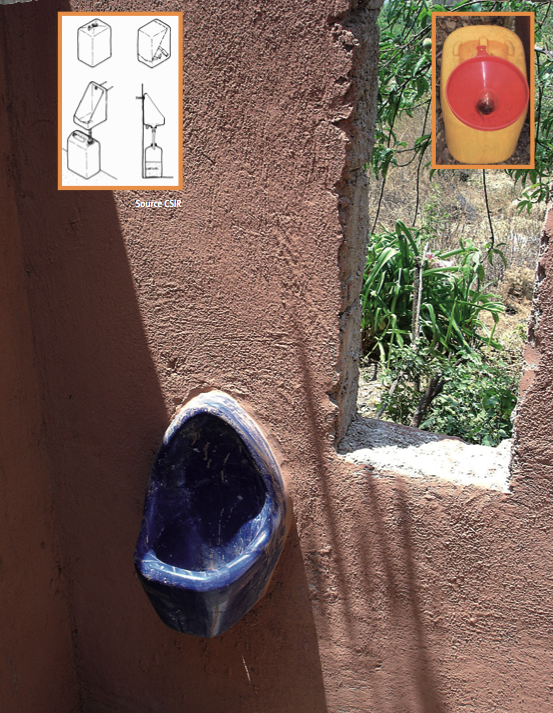Urinal
|

|
|
| |||||||||||||||
A Urinal is only used for collecting urine. Urinals are generally for men, although Urinals for women have also been developed.
Urinals for women consist of raised foot-steps and a sloped channel or catchment area for conducting the urine to a collection technology. For men, Urinals can either be wall-mounted units that are vertical, or squat slabs that the user squats over. Most Urinals use water for flushing, but waterless Urinals are becoming increasingly popular.

| Advantages | Disadvantages/limitations |
|---|---|
| - Does not require a constant source of water - Can be built and repaired with locally available materials - Low capital and operating costs |
- No real problems with odours if used and maintained correctly |
Adequacy
The Urinal can be used with or without water and the plumbing can be developed accordingly. If water is used, it is mainly used for cleaning and limiting odours (with a water-seal). Water-based Urinals use 8 to 12 litres of flushwater, whereas low-flush models use less than 4 litres of flushwater. Because the Urinal is exclusively for urine it is important to also provide another toilet to be used for faeces. Waterless Urinals are available in a range of styles and complexities. Some Urinals come equipped with an odour seal that may have a mechanical closure, a membrane, or a sealing liquid. To minimize odours in simple Urinal designs, each Urinal should be equipped with a dedicated pipe that is submerged in the collected urine (or tank) to provide a basic water-seal. Portable waterless Urinals have been developed for use at large festivals, concerts and other gatherings, to improve the on-site sanitation facilities and reduce the point load of wastewater discharged at the site. In this way, a large volume of urine can be collected (and either used or discharged at a more appropriate location or time) and the remaining urine/faeces toilets can be reduced or used more efficiently. Urinals can be used in homes as well as within public facilities. By putting a small target, or painted fly near the drain, the amount of spraying or splashing can be reduced; this type of user-guidance can help improve the cleanliness of the facility. Urinals are appropriate for every climate.
Health Aspects/Acceptance
The Urinal is a comfortable and easily accepted User Interface. In some cases, the provision of a Urinal is useful to prevent the misuse of dry systems (e.g. UDDT). Urinals, although simple in construction and design, can have a large impact on the well-being of a community. When men have access to a Urinal, they may be encouraged to refrain from urinating in public, which reduces unwanted odours and allows women to feel more comfortable. Men have generally accepted waterless Urinals, as they do not call for any change of behaviour.
Maintenance
Maintenance is simple, but should be done frequently. Minerals and salts may build up in pipes and on surfaces where urine is constantly present. To prevent scaling, slightly acidic water and/or hot water can be used to dissolve any minerals that form. All of the surfaces should be cleaned regularly (bowl, slab and steps) to prevent odours and to minimize solids formation.
References
- Elizabeth Tilley et.al (2008). Compendium of Sanitation Systems and Technologies (low res version). Department of Water and Sanitation in Development Countries (Sandec) at the Swiss Federal Institute of Aquatic Science and Technology (Eawag). (Provides a full overview of sanitation systems.)
- Austin, A. and Duncker, L. (2002). Urine-diversion. Ecological Sanitation Systems in South Africa. CSIR, Pretoria, South Africa. (Directions for making a simple Urinal using a 5L plastic container.)
- CREPA (2008). Promotion de latrines ECOSAN à la 20è édition du FESPACO: Ecosan Info No. 8. Centre Régional pour l'Eau Potable et l'Assainissement à faible coût (CREPA), Burkina Faso. Available: http://www.reseaucrepa.org
- GTZ (1999). Technical data sheets for ecosan components: Waterless Urinals. GTZ, Germany. Available: http://www.gtz.de (Information about specialized urinals, which include stench traps and other specialized features.)
- Netherlands Water Partnership (NWP) (2006). Smart Sanitation Solutions. Examples of innovative, low-cost technologies for toilets, collection, transportation, treatment and use of sanitation products. NWP, Netherlands. (Provides country specific data and links for further information.)
